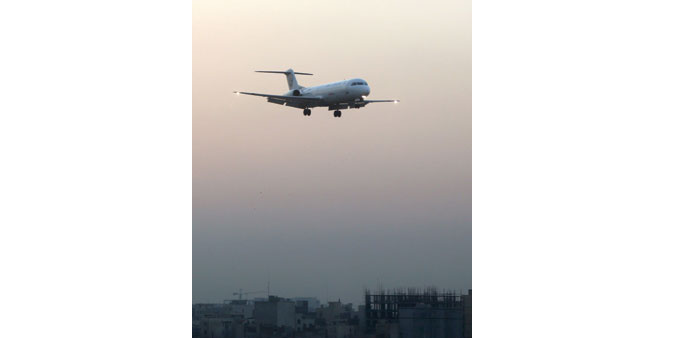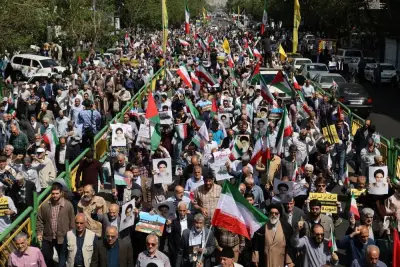A plane of an Iranian airline approaching Mehr-Abad airport in Tehran (file). Iran needs about 400 passenger planes to renovate its fleets, which would cost $20bn, Abbas Akhoundi, Iran’s roads and transport minister, said in mid-June at the Paris Air Show.
Bloomberg
Chicago/Dubai
The historic nuclear deal with Iran gives Boeing Co and Airbus Group a rare opportunity to reshape a civilian aviation industry.
Once the accord is implemented, the republic will be able to start replacing hundreds of museum-vintage jumbo jets that still rumble over Tehran as mainstays of an aviation fleet frozen in time by economic sanctions. The investment could total at least $20bn.
“There’s no doubt there is huge potential, especially for Airbus and Boeing, to sell a large number of planes,” said Adam Pilarski, an economist and senior vice president with Avitas Inc, a Reston, Virginia-based aerospace consultant.
The thaw could give the world’s two biggest planemakers, along with aircraft lessors, sales possibilities similar to those in Russia when its markets opened two decades ago. They are vying to serve the demand for travel that will come with greater consumer spending. Other companies - including cigarette retailers, auto manufacturers and soft-drink purveyors - also are poised to profit once sanctions are lifted.
Iran Air, the nation’s flag carrier, was once the region’s leading airline with two Concordes on order, a deal cancelled in 1980 after the revolution. Emirates Airline, based just across the Gulf in Dubai, plays that role these days as the largest operator of Boeing’s 777-300ER and Airbus’s A380 superjumbo jets.
Meanwhile, Iran Air flies A300s, the first aircraft Airbus created, and Boeing 747-200s delivered in the mid-1970s, according to Planespotters.net. The average age of its planes is 27 years, compared with 6.3 years for Emirates, data on the website show.
Decades of US sanctions, which prohibited Toulouse, France-based Airbus, Chicago’s Boeing and other Western manufacturers from selling to Iran’s airlines, led to an aging fleet of mainly Shah-era relics or jets purchased on the black market that now are in urgent need of repair and replacement. Safety is a concern following a rash of fatal air crashes.
Iran needs about 400 passenger planes to renovate its fleets, which would cost $20bn, Abbas Akhoundi, Iran’s roads and transport minister, said in mid-June at the Paris Air Show, according to the Islamic Republic News Agency. The country has about a dozen carriers.
As Iranian travel takes off, there should be demand for 200 narrow-body aircraft orders and more than 250 wide-body and jumbo jets seating between 300 and 450 people, estimates Mark Martin, founder and CEO of Dubai-based Martin Consulting.
Iran Air will need about 100 new aircraft, from the latest single-aisle planes to long-haul models such as Boeing’s 777, 787 Dreamliner and Airbus’s A330 and A350 jetliners, chairman Farhad Parvaresh said in a June 2014 interview.
Both Boeing and Airbus declined to comment on Tuesday on their plans to enter the Iranian market once trade barriers are lifted.
“We’ve done a pretty good assessment on our side and we think the demand, should things open up, would be very strong,” Marty Bentrott, Boeing’s vice president of sales for the Middle East, Russia and Central Asia, said during a May interview in Dubai.
A freer Iranian market also could boost sales of regional jets made by Brazil’s Embraer, Canada’s Bombardier and new entrants such as Russia’s Sukhoi and Commercial Aircraft Corp of China Ltd, said Thomas Pellegrin, director at PricewaterhouseCoopers’ Aviation Center of Excellence research office in Dubai.
What isn’t clear is how quickly the Iranian government will move to upgrade air travel given other demands on its capital for rebuilding sagging infrastructure, from oil refineries to air-traffic systems.
“This is a state-controlled economy,” said Richard Aboulafia, an aerospace analyst with Teal Group, a Fairfax, Virginia-based consultant. “It’s not exactly ripe for an Iranian version of EasyJet.”
The forecasts for hundreds of orders “remain aspirational for now,” since the hospitality industry the airlines would feed barely exists, Pellegrin said in an e-mail.
Multiyear waiting lists for popular models such as Airbus’s A350 and Boeing’s 787 Dreamliner, combined with the steep capital requirements of aircraft purchases, may prompt Iran’s carriers to lease jets rather than order new models, he said.
Aboulafia is sceptical the large orders will ever materialise given the disadvantage Iran’s carriers face compared with rivals Emirates, Abu Dhabi-based Etihad Airways and Qatar Airways.
“At most, there may be some opportunity for lessors to place some aircraft,” he said in a phone interview. “We aren’t opening up some sort of greenhouse that hasn’t seen the light for years. The demand has gone to the three big Gulf carriers, which all serve Tehran.”
Even so, Iran’s unlocked oil revenues and dismal safety record will prompt its government to pursue new aircraft purchases regardless of the business case, said Pilarski, a former chief economist and director of strategic planning with McDonnell Douglas Corp, the planemaker Boeing bought in 1997.
The country doesn’t have the maintenance capabilities to service large numbers of used, current-generation jets, and newly resurgent Iranian carriers won’t want to risk being banned in the European Union for a sub-par safety record, he added.
“They are itching to have new equipment” after not having it “for a long, long, long time,” Pilarski said.



